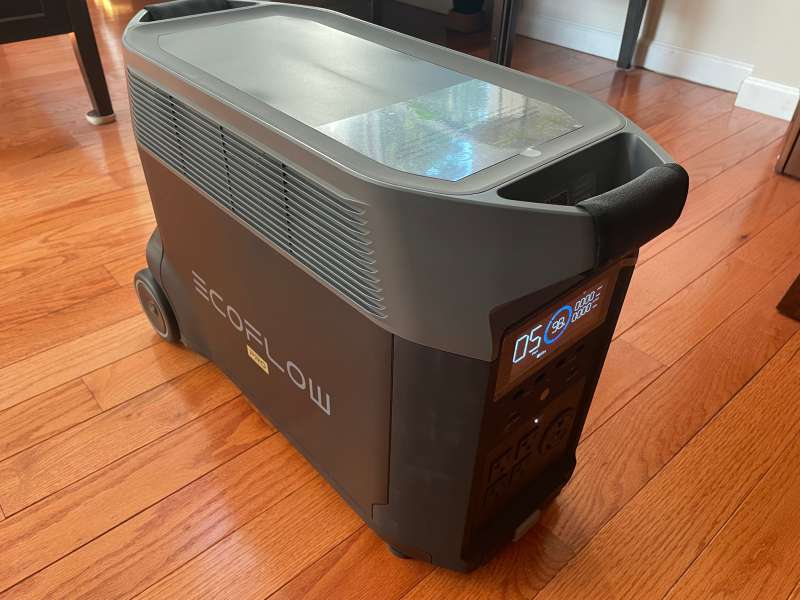
REVIEW – We are all insanely attached and dependent on our devices, even more so if you are of the Gadgeteer ilk. The EcoFlow Delta Pro Portable Power Station which is currently seeking funding on Kickstarter serves to keep your home, cabin, or camp purring along when power poops out, keeping your gaggle of gadgets alive.
What is it?
The EcoFlow Delta Pro Portable Power Station is a self-contained battery, high-voltage AC inverter, and low-voltage power supply that can power many devices in the event of power loss or need for power in remote locations.
Hardware Specs:
- 99 lbs
- 25 x 11.2 x 16.4 inches
- 3600Wh, 48-volts
- UL,CE, FCC, RoHS, and Telec certified
- Wifi supported
- Bluetooth supported
- Pure sine wave inverters
- Five AC output sockets, 120-volt, 60Hz, 3600W total (7200 W surge)
- Two USB-A charging ports, 2.4A, 12W maximum per port
- Two USB-A Fast-charge ports, 5V at 2.4A, 9V at 2A, 12V at 1.5A, 18W maximum per port
- Two USB-C ports, 5/9/12/15/20V at 5A, 18W maximum per port
- One Car charger socket, 12.6v at 10A, 126W maximum
- Two DC5521 outputs, 12.6V at 3A, 38W maximum
- One Anderson output socket, 12.6V at 30A, 378W maximum
- One X-Stream 1800W input charging port
- One AC voltage input charging port, 100-120V, 15A or 220-240V, 12A, 50/60Hz
- One Solar charging input port, 11-150V, 12A Maximum, 1200W maximum
- One car charging input port supports 12 and 24VDC vehicles, 8A current draw
- Internal LPF battery
- 1-Year battery retention after full charge
- Over-voltage, overload, over-temperature, under-temperature, short-circuit, low-voltage, and over-current protected
- 14 – 113°F operating temperaute range, 68 – 86°F optimal
- 14 – 113°F discharge temperature
- 32-113°F Charge temperature
- Languages: English, German, Japanese, French, Spanish, Italian
- Screen Resolution: 1280X800
- Two Delta Pro smart battery (optional) expansion ports
- One Smart Generator (optional) port
- Delta Pro remote control (optional) capable
- Double-voltage hub (optional) compatible
- EV X-Stream adapter (optional) to connect to EV charger
What’s in the Box?
- EcoFlow Delta Pro battery and inverter assembly
- AC charging cable
- Car charging cable
- Solar charging cable
- DC5221 to DC5525 adapter cable
- Handle cover
- Delta Pro to Smart Generator Adapter
- Manual and warranty card
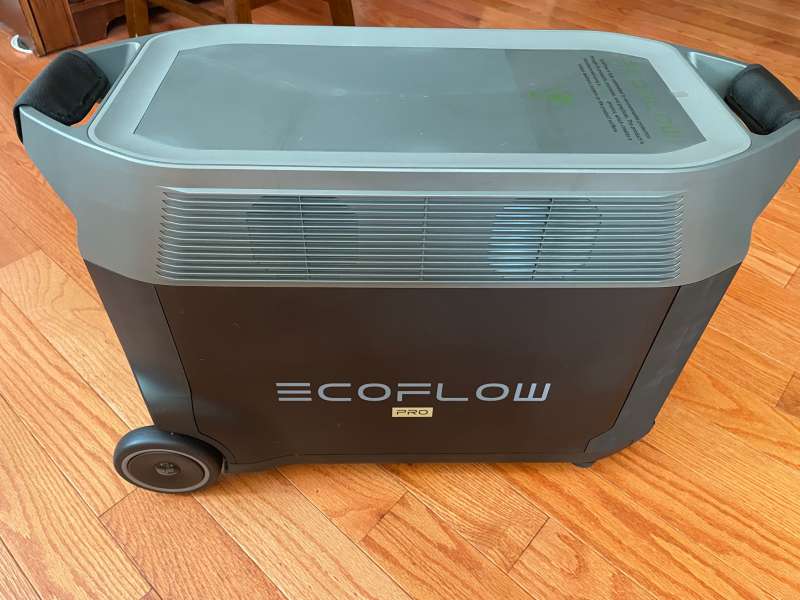
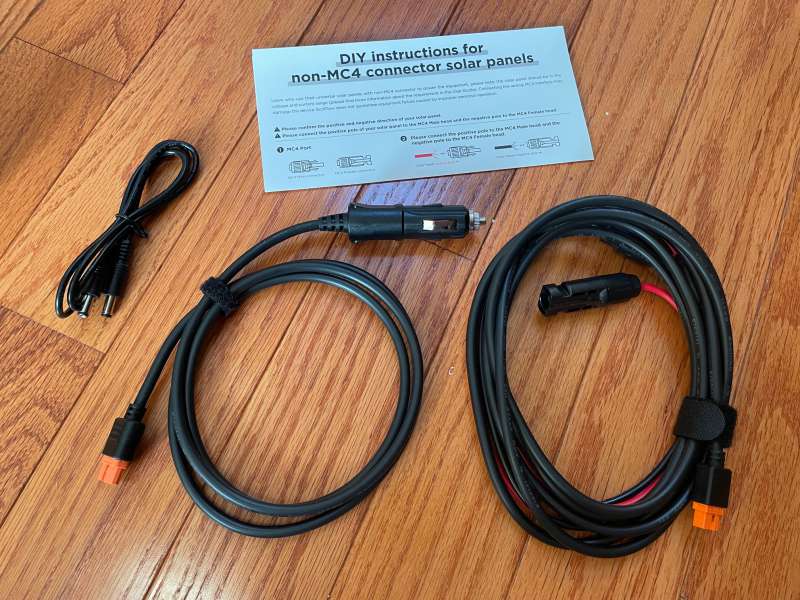
Design and Features:
I live at the end of a power circuit and any problems upstream result in a loss of my home’s power. I can’t begin to tell you the frustration of having no power, yet being able to look across the street and see my neighbors going about their activities without a care. In some circumstances, friendly neighbors have permitted long extension cords to keep freezers from thawing, sump-pumps running to prevent flooded basements, and to even power a home’s heater to warm things up before lasting a long, cold night and help prevent pipes from freezing.
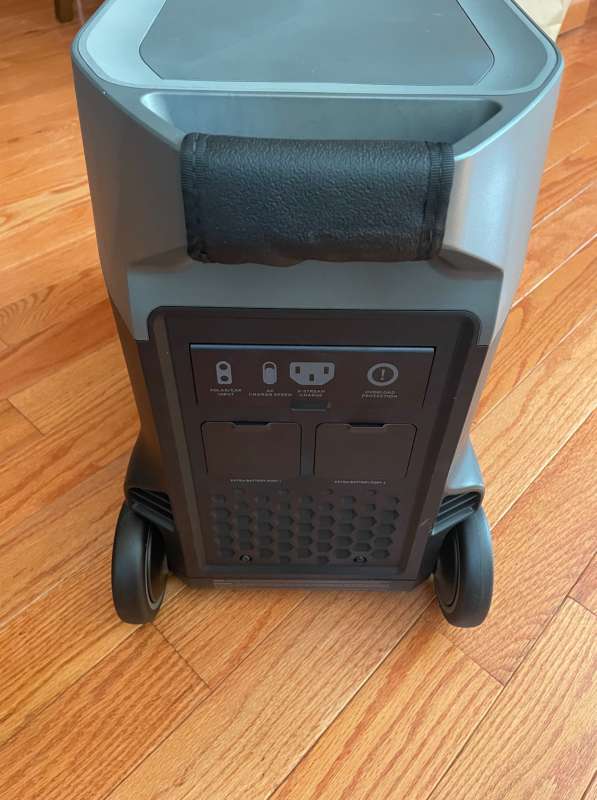
Because I’ve “been there, done that,” I’m a bit OCD about having a backup power plan. I have a generator, but it’s cumbersome to connect (especially frustrating if the power outage is only a few hours), consumes a fair amount of fuel, the exhaust is toxic, it’s noisy, and, it requires maintenance to keep it going. Transporting and storing the gas is a pain, and to make matters worse, I hate the smell, yuck! I’ve slowly made the move away from fossil fuels, and even have an electric ride-on lawnmower and hybrid car to lower my gas usage as much as possible. Now, only my snowblower and backup generator use gas. Not using gas has another huge bonus – the Delta Pro can be stored and used indoors with no exhaust, no risk of carbon monoxide poisoning, and no noise (except the cooling fans).
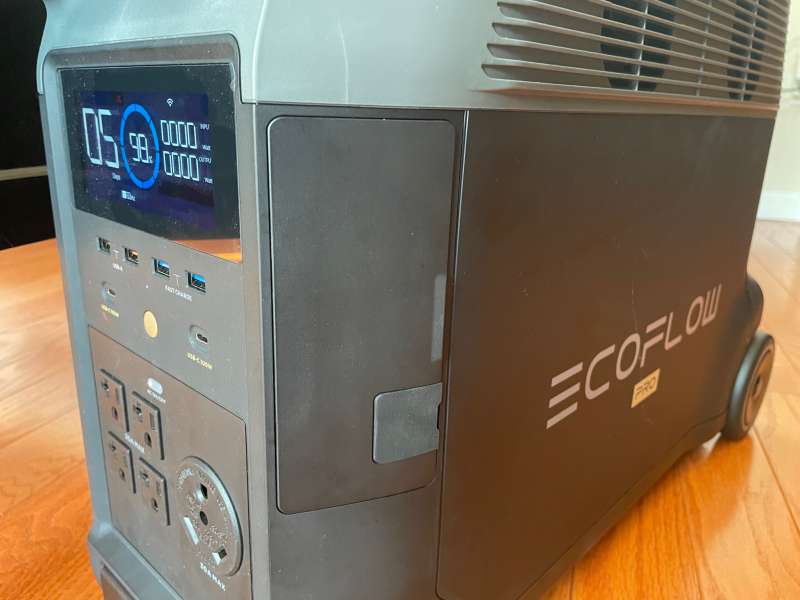
For several years, I’ve made several stop-gap measures to deal with power loss issues – I’ve used USB battery packs to keep phones and computers running, inverters with a bare car battery to run my furnace flowing, and various small options to keep my freezer cold and sump-pump running to prevent my basement from flooding. When necessary, I fire up a generator to keep multiple things going at once. Sure, it’s possible to buy a large generator or a roof full of solar cells and backup batteries for household power, but these solutions are comparatively expensive, require professional installation, and have their own sets of maintenance quandaries.
Enter EcoFlow… I was suitably impressed when I found EcoFlow’s offerings on Kickstarter and jumped at the opportunity to get my hands on one of their products.
The EcoFlow Delta pro arrived in a sturdy cardboard box with foam inserts. Sturdy is definitely required because the Delta Pro is a beast at nearly 100-pounds.
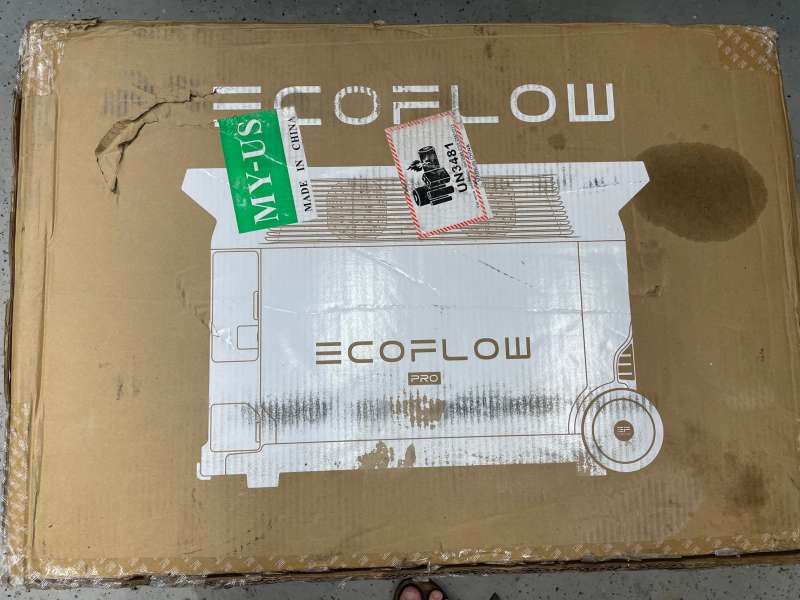
It’s not something I want to be lugging around Higglety-pigglety, but EcoFlow’s design team thoughtfully added a luggage-style extendible handle, padded handles, and strong wheels to make mobility a bit easier.
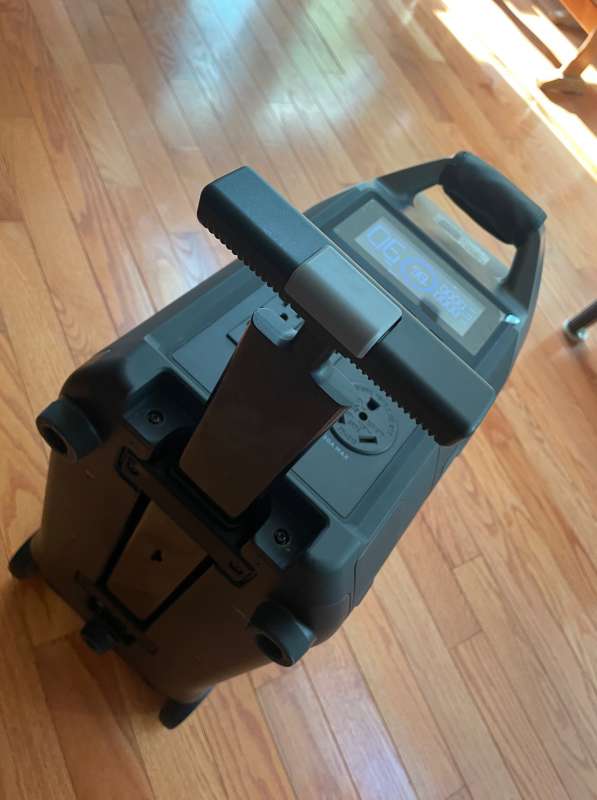
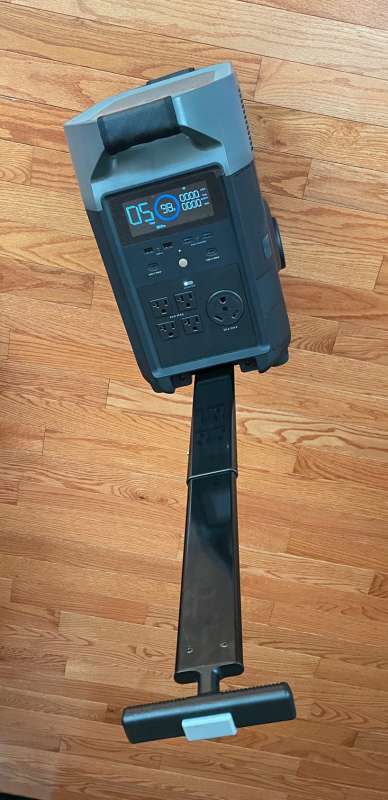
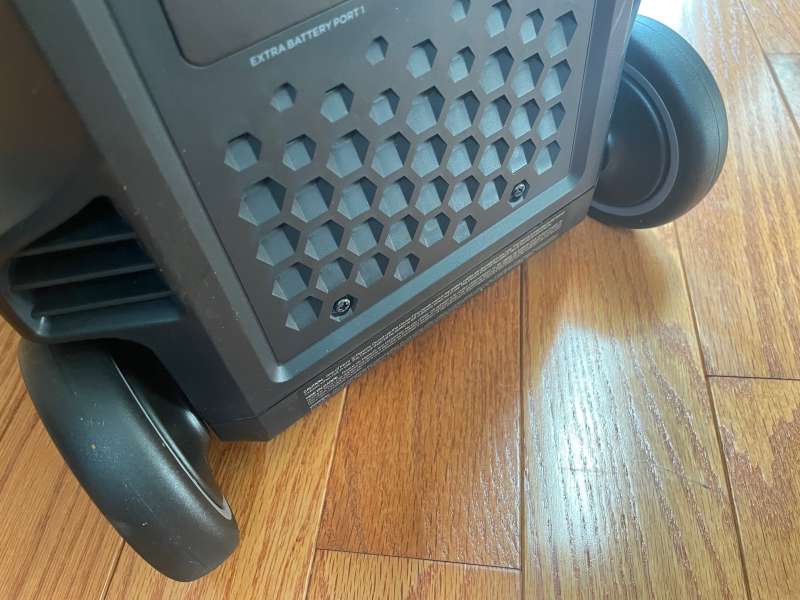
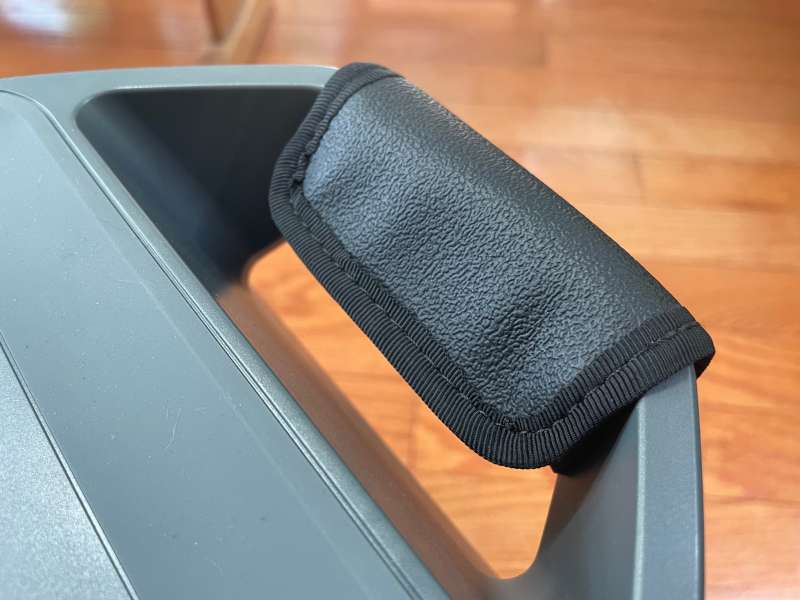
EcoFlow includes several charging cables for standard AC sockets, charging in a vehicle, and solar although solar panels are optional accessories. As an electrical engineer, I was admirably impressed with the charging voltage and current ranges.
Charging this mammoth power station from a wall socket is shockingly fast! According to my amp meter, it drew a peak of 14.8 Amps during charging – that’s a full 1800-Watts and is powerful enough to fully charge in just over 2 hours from a 120-volt socket. VERY impressive! But wait… there’s more!… the app allows for customized charging levels should your system be limited in its Amperage capacity, for example, mobile home parks that limit power socket usage to 15-Amps and the circuit needs to be shared with other gadgets.
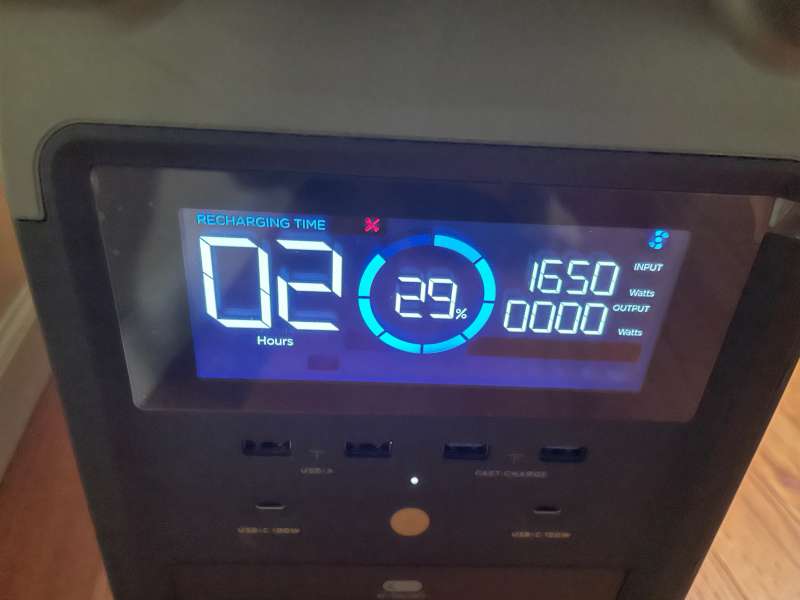
Equally as impressive, the Delta Pro can simultaneously charge from AC and DC supplies AND can output power while doing so. This is a big plus in my book! This means the portable power station can pull power from a car’s power socket or solar panels*, convert them to the USB, or AC power needed, and any excess power not being used by the output is pumped back into the battery – simultaneous use and charging.
You might ask, “Why is simultaneous charging and usage important?”
For one, because the inverter power output on the Delta Pro is very… very… clean, perfect sine-waves that translate into happy, healthy gadgets. Sine wave power, AC (alternating current) is what your house uses. Motors and other loads are designed to work optimally using this type of power. Unfortunately, some inverters (power converters that change direct current (DC) to alternating current (AC)) use a “modified sine wave” that makes the normally smooth power have “stair steps” instead of smooth waves. These “stair steps” in power can cause buzzing of speakers and, hotter than normal operation, and even cause sensitive electronics (computer power supplies, for example) to fail. EcoFlow’s design ensures this doesn’t happen.
Next, simultaneous charging and output reduces the guesswork and cable swapping when keeping things up and running – after making the connections, power flows in and out of the Delta Pro system automatically without fiddling with cables or plugs. If there is enough supply for the Power Station to charge and enough capacity in the batteries to power the devices plugged in, it just works.
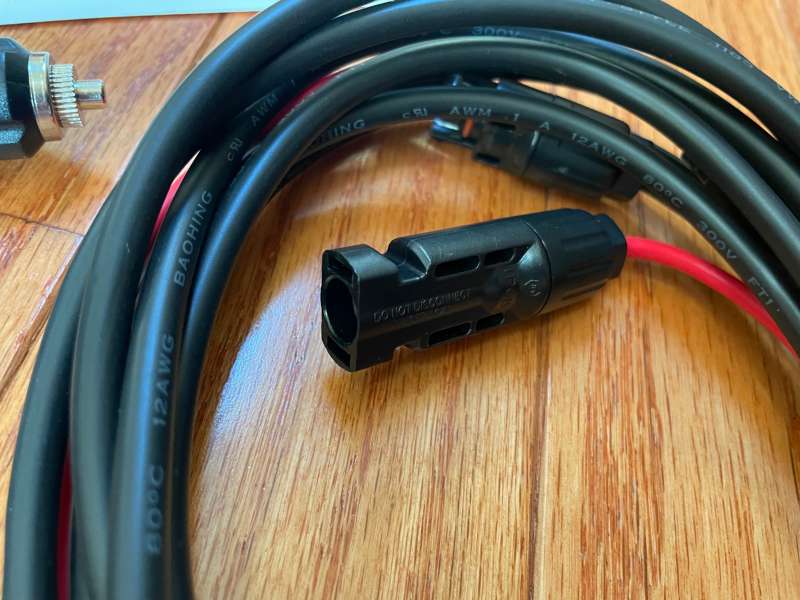
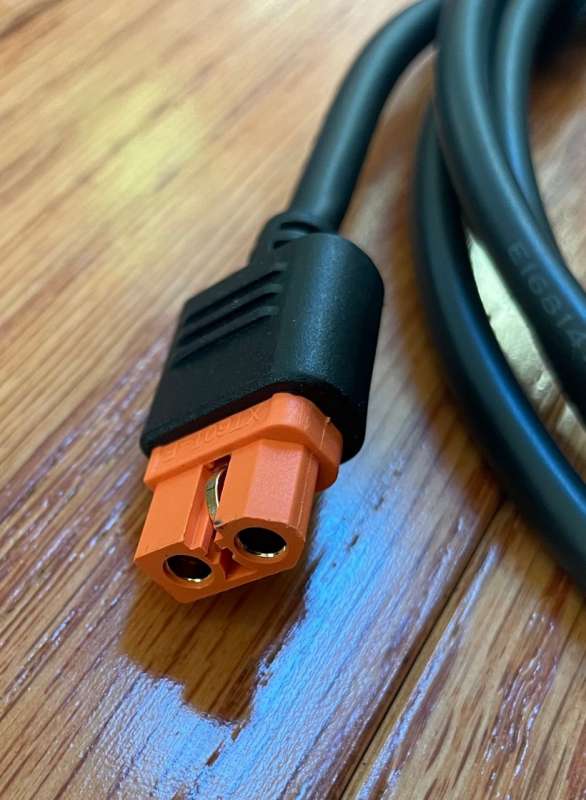
To make the system even more versatile, using an adapter, the Delta Pro can be charged from electric car charging stations and a gas-powered Smart Generator*!
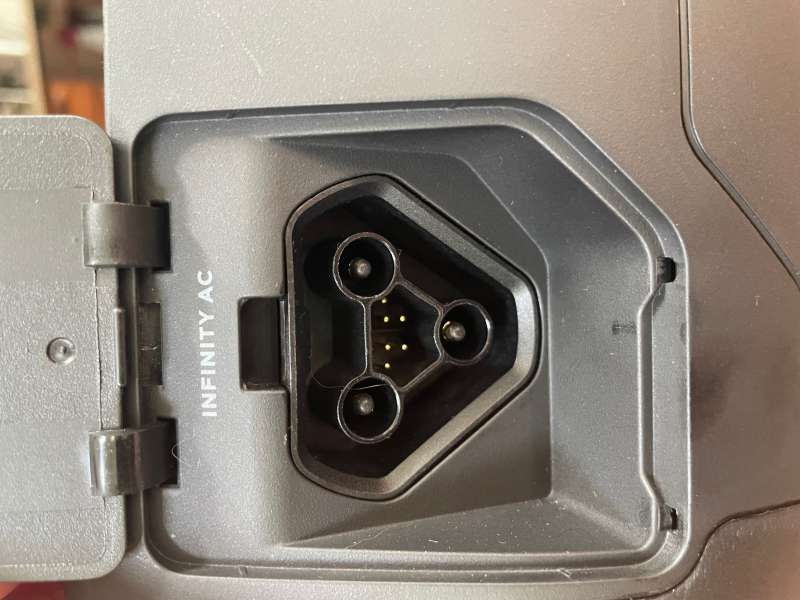
Input ports are located on the “tail” end of the Delta Pro.
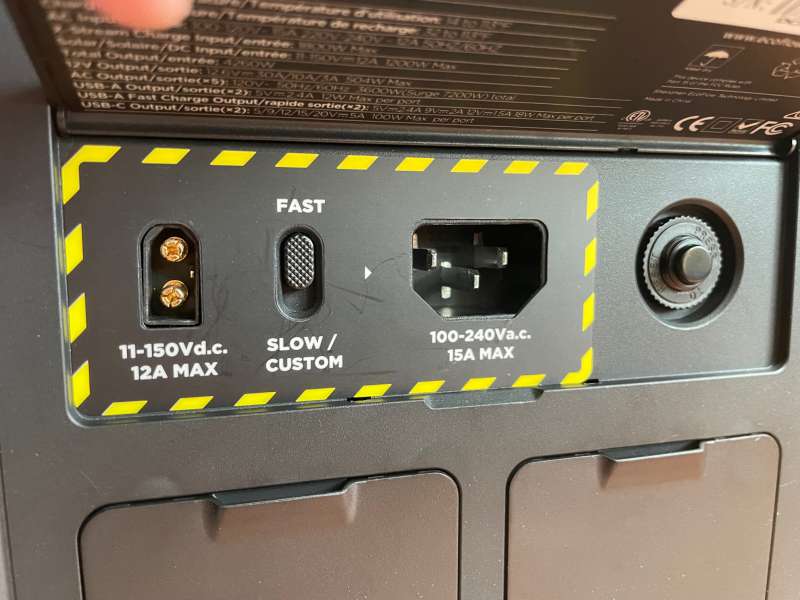
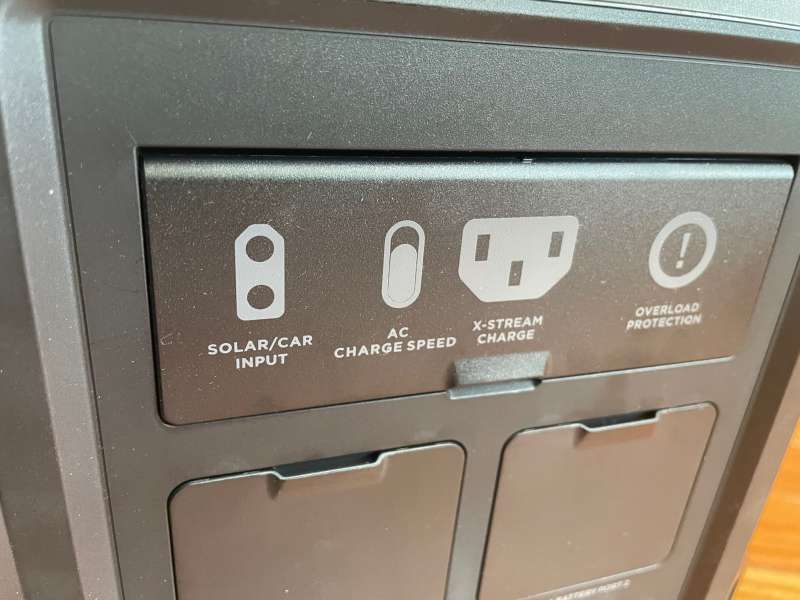
Outputs on the Delta Pro are aplenty, powering everything I could throw at it – my freezer, my refrigerator, a fan, TV, end even an 1800-Watt microwave was no problem. Even at 1800 Watts, the Delta Pro could have powered my microwave for two continuous hours!
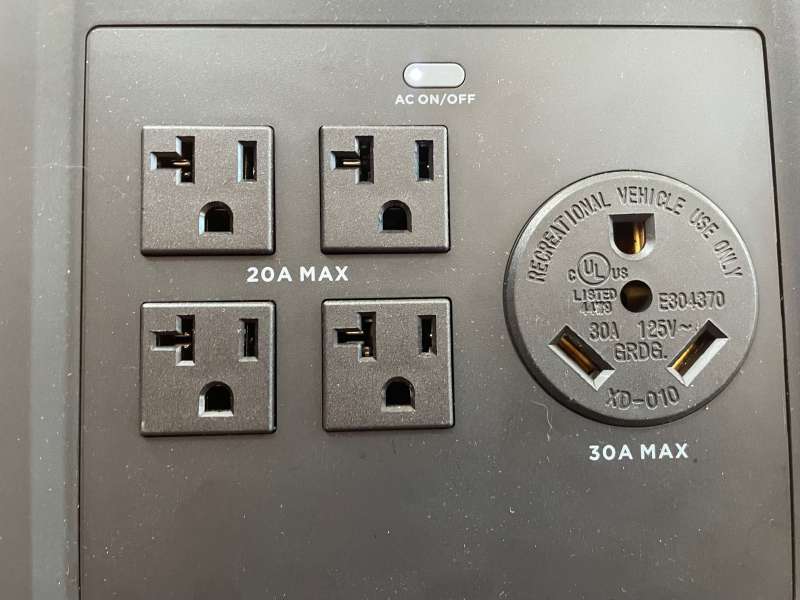
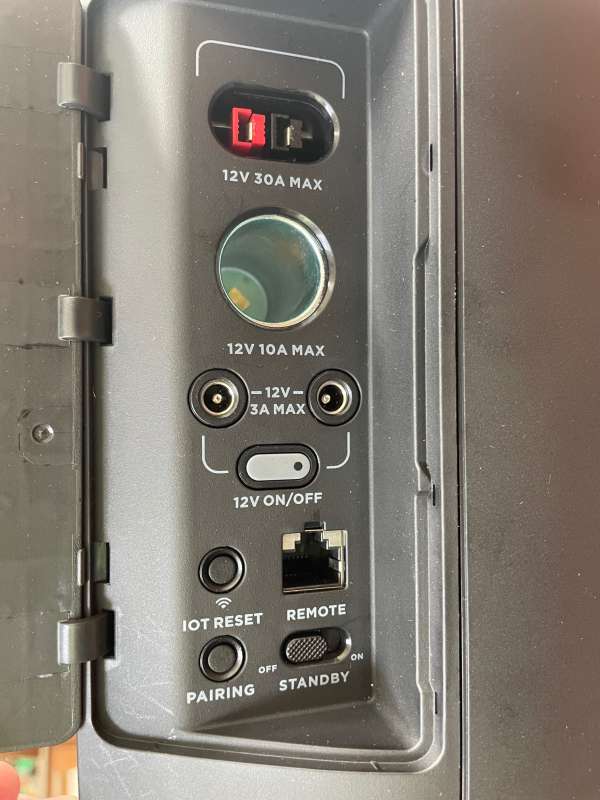
Translating this into smartphone numbers, the Delta Pro should be able to fully charge my iPhone 12 Pro a staggering 250 times!
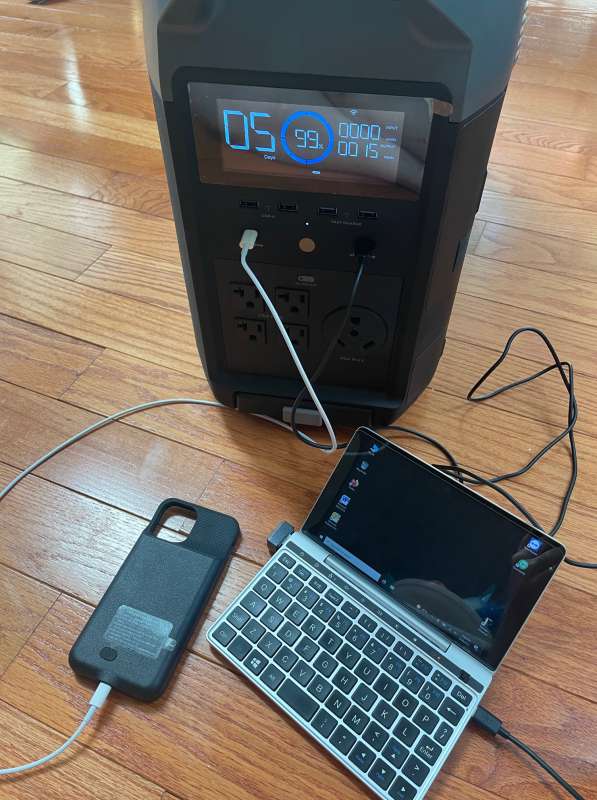
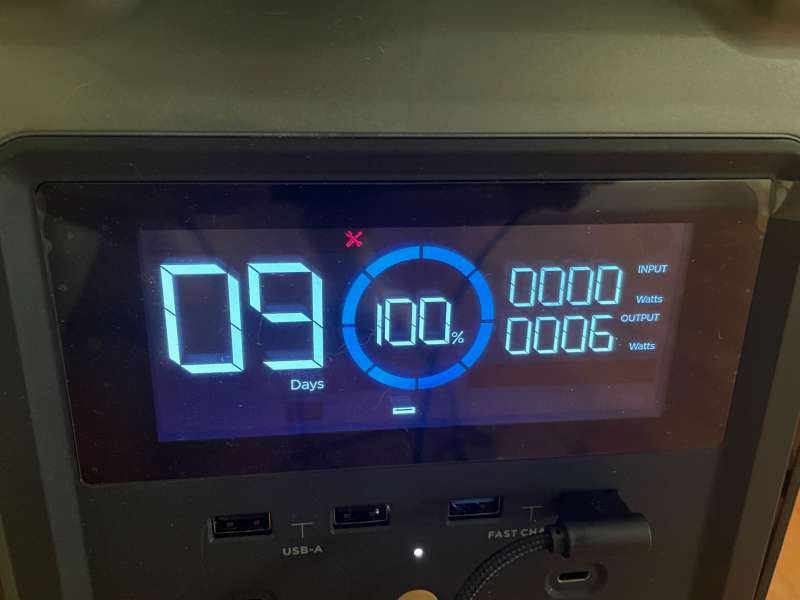
EcoFlo has an interesting solution for devices HIGHER than 3600 watts without overloading – X-Boost lowers the output voltage and current to inductive loads (like power drills, hairdryers, and waffle irons) to allow the device to operate. Very clever!
To increase the utility, the Delta Pro can be expanded to add two additional optional external batteries and a home connection kit*. This is particularly noteworthy because it not only increases the system capacity but also allows the voltage to be increased to 240-volts, two-phase power. This means that the Delta Pro can power ALL of the devices in your home, including your furnace, clothes dryer, or electric oven. I don’t know of any other inverter-based backup power system that has this capability. Wow, EcoFlow, wow!!
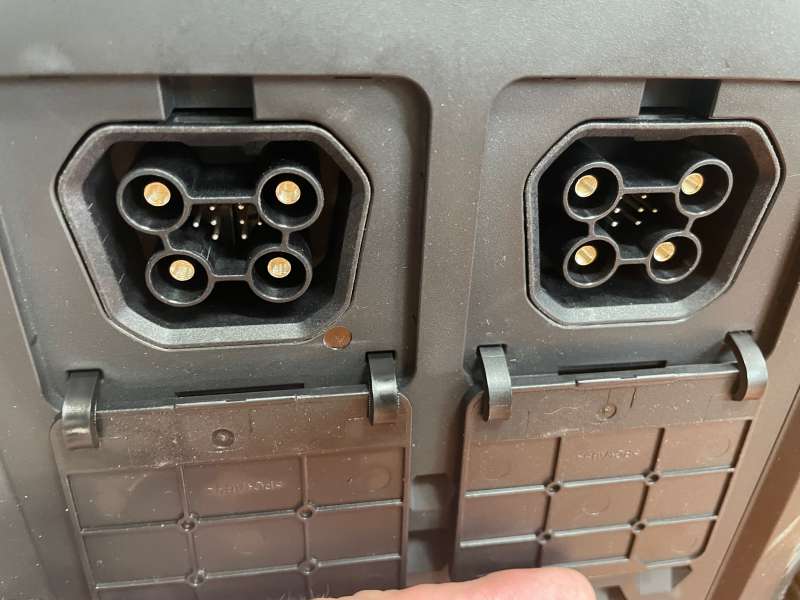
The Delta Pro’s bright, multicolor display provides the percentage of power available, input and output wattage, an estimate of the time remaining at the present current draw, connected device status, indicators, and warnings.

To sweeten the experience, EcoFlow’s app is fantastic! All of the functions of the Portable Power Station can be monitored, ports can be turned on and off.
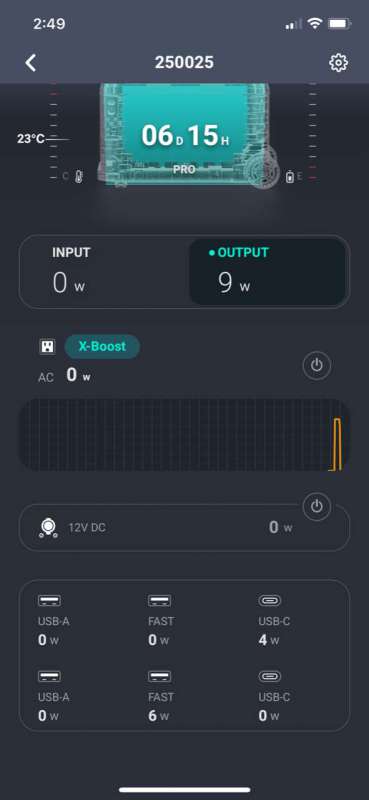
Even more app options can configure virtually everything on the Delta Pro as well as update software.
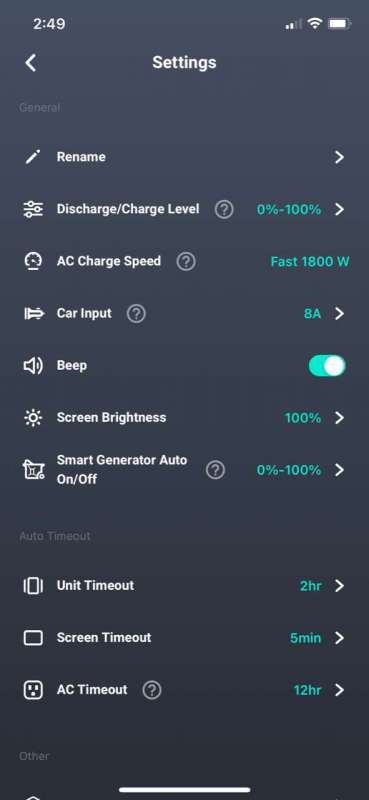
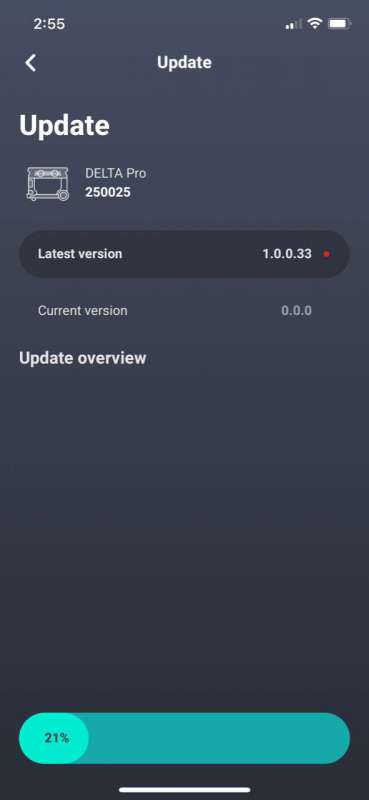
The app even has a section providing the complete specifications. I love this!
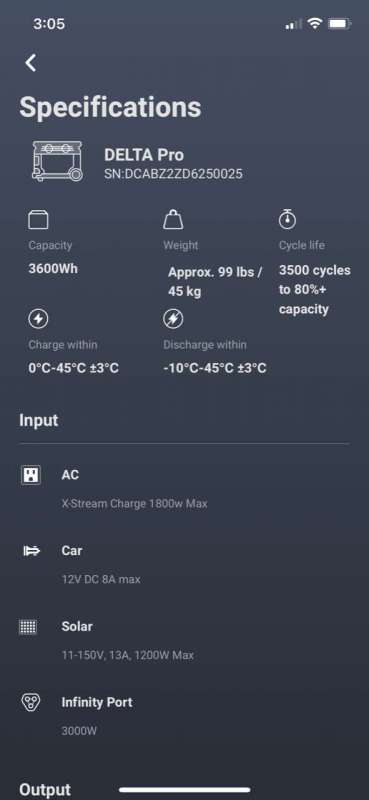
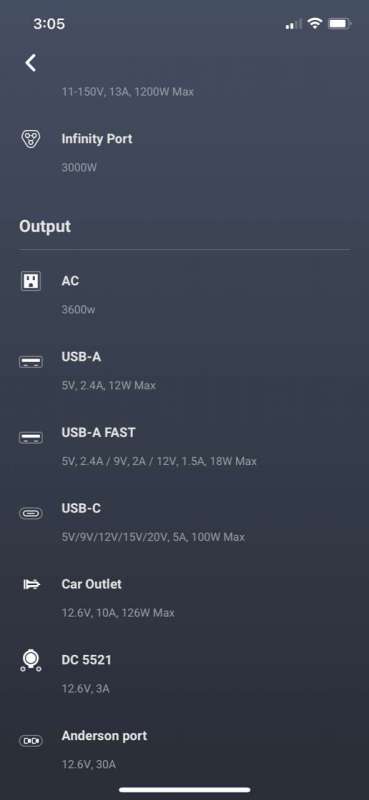
*EcoFlow didn’t include Extra Smart Battery, Smart Generator, Delta Pro remote control, Double-Voltage Hub, Solar Panels, or EV X-Stream electric vehicle charging adapter for review, but this system is so impressive, I would be thrilled to review them in the future!
What I Like
- Lightning-fast charging
- Oodles of input and output choices
- Modular and expandable
- Portable
- Outstanding performance!
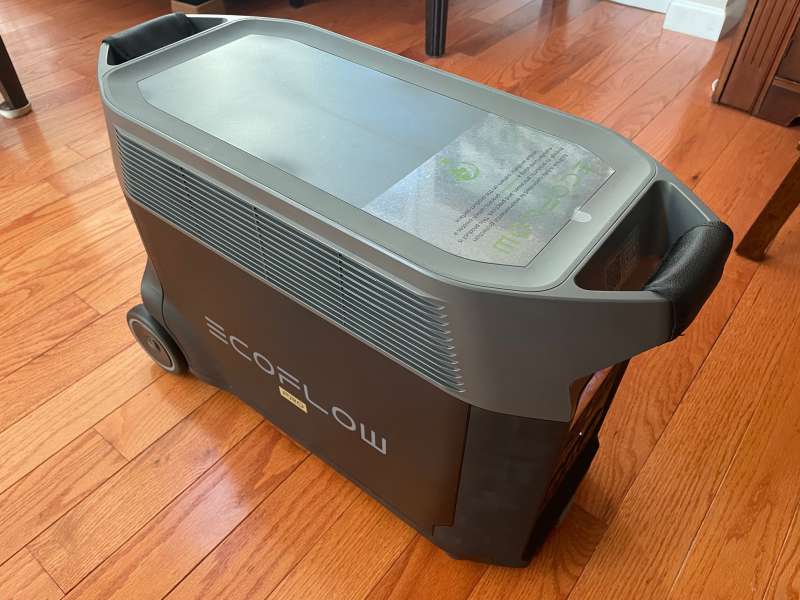
What I Would Change
- Nothing! This system is amazing! The engineers at EcoFlow have thought of everything! The system is crazy modular, expandible, and shockingly innovative!
Final Thoughts
EcoFlow’s Delta Pro is one of the most innovative, efficient, well-designed products I have had the pleasure of reviewing. It’s incredibly capable, the design and features are off the charts, and its expandability is nothing short of amazing! Bravo, EcoFlow, Bravo!
Price: $3599.00
Where to buy: EcoFlow
Source: The sample for this review was provided by EcoFlow.



Gadgeteer Comment Policy - Please read before commenting
If your power is off for a few days, this thing becomes a boat anchor quickly. Why not convert your gasoline powered generator to clean burning natural gas (if available) or propane so you won’t have to mess with liquids? For almost three grand (which this would cost with sales tax and shipping), you can set up your (or a 5,500 watt one) small generator with a transfer switch and gas piping or a propane tank.
I suspect this expensive unit will be good for camping and occasions when power is off for a short time. My friends who camp a lot have 2,000 watt portable gasoline powered generator/inverters that cost a fraction of this unit.
We are in Houston, Texas and can see long power outages occasionally.
I live in Houston as well and I don’t see these being a viable option for us. However, if you live where you have frequent short outages, I can see the draw.
I have a generator that I will be converting to natural gas this weekend. This remains the most cost effective option for me. BUT, as the price of these things continue to drop, I can see one being more attractive.
Except any of the 2000/2200 watt inverter gensets are pretty much dual fuel already nowadays, fairly quiet, and weight half the weight of this giant thing. For glamping this thing is unwieldy. I can take about as much space with my Honda 2000 and propane, with less power, but much longer run times. The again, when I’m camping I don’t need electronics so the point is moot but still a waste of $3,000 on this thing except for yuppies and “reviewers” that get it for free.
Not to mention there is pretty much zero two phase systems in the entire world. It’s either single phase or three phase. USA is generally a single (split) phase in residential settings. Not sure where the 240v comes in but I guess the “home kit” must have a 240v receptacle of some kind that comes with it as that interface is all 120v.
Came here to say this. “2 phase 240 volt”? I guess it’s possible but why make something that no one could use. Far more likely that the author doesn’t know what he’s talking about. Was gonna let it slide but he went out of the way to call himself an electrical engineer. Meanwhile, I don’t work with electricity at all beyond hobbyist stuff and know that 240v is single phase.
Beyond free, would bet they get a kickback from referrals on this thing too.
Two phase? I design control systems for automated machines and have never had anyone ask me to implement “two phase” power. I can only imagine it to be something created by science fiction writers.
Yep phase is outdated, not science fiction. In the early days of ac power it was a lot more popular.
For clarity, the nomenclature I chose as “two-phase” was intended for clarity for laymen. I thought it would be easier than explaining how split phase distribution works. My apologies to purists and engineers.
And no, we don’t receive residuals.
Actually, we do receive an affiliate fee if someone buys this product from the link in the review.
What country is the EcoFlow Delta Pro manufactured in?
Just to help.Countries have different voltage and frequency considerations.Google search
He probably means two 120 volt power connections to make 240 . Single phase -120. Two phase 240 volt. Three phase is three hots.
That’s not how phases work though, both 120v lines are in phase with each other, meaning separate hots but single phase. There is a true two phase style of power, but it’s outdated and almost nothing uses it.
I agree in part. I have a $15,000 battery and solar system that I quickly found out NEEDED a gasoline backup for cold and overcast days when batteries WILL NOT charge fully and WILL operate at reduced capacity due to cold temperatures. In these circumstances GASOLINE or other fossil fuels are EXCELLENT backup and can save your life! Relying on renewable energy alone is a huge mistake that I only made one time when living off grid.
Something is not sized right. Sounds like you need more panels to compensate for cold/cloudy days.
I have a 5.12 kW system in Iowa, just installed last year. I’ve been happy with it so far but I did go about three weeks receiving almost nothing from the panels in February–because they were covered with snow. More panels wouldn’t have helped. I haven’t installed batteries yet due to supply issues (and also net metering making them uneconomical *except* as backup power) but I’m strongly considering a small natural gas generator to supplement the panels as part of a comprehensive backup system. (On the positive side, the generator wouldn’t need to be sized to supply peak power for the whole house due to the batteries.)
Anthony
I live in Spring, Texas and I don’t know anything about generator.
What all will that run at one time
This would be a good complement to a generator if you have modest power requirements. Would keep the fridge on most of the day, and TV, lights, etc without having to have the generator run 24/7.
Would love lithium batteries, but currently I have a 10,000 Watt-hour lead-acid bank that will cost me <$1000 to replace every 5 years. I live off grid and only have to run a generator after days of bad weather.
This is the real value for this system. keeping the fridge, freezer, TV, lights, etc without having to have the generator run 24/7. you can add a small window unit AC also. Run max solar 1200 to 1600 watts and top off with 2000/3000watt generator.
This is a power storage. Not a generator.
Generators are noisy. You can use one to charge those batteries before nighttime. This way you can sleep in silence.
This unit works in conjunction with generator / solar panels / wind turbine.
This is a complete lie. I’ve had mine powered off for a few months left at 80% charge. (When storing I never leave it above 80% No issues plugging it in and charging it full up as we go into storm season. When coupled with solar these things can go indefinitely, vs gas generators. Stop being scared of change.
Great write up!
Did i miss something: I see the „*“ next to solar, and you don‘t write about hooking up an external solar panel charging panel/unit to this device. Is there a catch? How does one do this?
Drop down to end of article and see *’d paragraph. Lists each item noted with an * in artcle that could be a add-on/attachment/accessory but does not come with, nor included with, the basic package.
LPG automatic switchover generator. 18,000 watts instead of the 3600 watts for this unit. Will run until your LP runs out. $4970 at Lowes. A much much better solution than this unit.
Two phase, 240 volt, is what household power panels are. The two phases are 120 volts each.
No they aren’t. 240v in your house, and every house, is single, or split if your prefer, phase. Never 2 phase. There is essentially no such thing in modern use.
Titan solar generator is better because you do not have to throw it away when the battery is spent. You also have a external port for a lithium iron phosphate battery which has a much longer battery life. You also can input 2000 watts in solar panels instead of 1000. There also might be a wait before you can recharge this unit if it gets hot. I have an echoflow delta and it throttles charge time when it is mildly warm. If you are looking for something to cycle everyday….it is tough on the echoflow delta.
Delta pro is build in to cover outdoor and indoor power solution….that’s why it is also name as Genset. I am living at Indonesia, here the power supply 220 to 230 volt AC. Is there any option to use Delta pro here. How much power I can use here at Indonesia. Pls let me know
Ok, at $99 for 3.6 kwh….that makes the price about $28 per kWh. Tesla Powerwall is $600/khw…..and the cheapest lead acid battery is $120 per kWh. Tesla boasts the most efficient low cost battery cell and claim to have made it at a cost of $100/kWh. How can these guys be at less than 1/3 the cost of Tesla with an inverter and a bunch of other electronics and no volume. Sounds like a scam.
Well for starters it’s only 3.6 kwh vs just over 12 kwh usable for a Powerwall. The PW is also tied into your electrical system for instant power backup. I’m sure peak power is higher on the PW as well. I def see a market for this but the OP is def getting some kickback for a very one sided article. I’m a Tesla fanboy and could list off several things I would love to improve with my Solar/PW setup and the OP says theres not a single thing they would change about this low capacity backup unit? How bout increased capacity so you could power more then a few hours in an emergency. For reference I’m on vacation (not home since yesterday and looking at my energy consumption for the day…no one at home everything set to eco and my home has consumed 9.8 kWh of power and its only 4pm. The title that click baited me to this article should be rephrased to a decent alternative to portable generator for the worksite because thats all it would be good for that and maybe keeping your fridge running for a day.
Lots of uses for this. Off grid cabin with solar, van life with solar, keeping your fridge and mobile phones powered for days in an outage, etc. Best of all, can use it inside with no maintenance. Not a high volume product though. The fast recharge beats the competition.
This in nothing but a giant UPS on wheels, I have several APC UPSs one can keep my PC, monitor, Fiber ONT and Synology NAS running for over 1 hour alone it can handle 1500w cont, add several batteries and it will run a lot longer, the Tesla power wall, solar battery banks, UPSs, and this device are all just Inverters nothing new the technology has been around a while now my first UPS was a Minute Man made in the 80s that had 30 GelCells in it that could keep a server running for a day it had 2 boxes one was reg inverter with the switch over, the other was the bank of batteries I swapped the batteries for AGM when the gels went bad to save thousands of dollars. This may have a use bit again it’s nothing new.
“Better than gas!”
Nope.
I’ve put 600 hours on my current 3500 watt inverter generator and will put a good 6000 on it before I replace the poor bugger, there’s no way a giant battery pack can replace it. My average usage gets over 10 hours out of a gallon of gas, almost 30 hours out of a full tank, and refilling it is not a hassle, it takes 2 minutes.
In some climates, such as mine, solar is just useless for days at a time. Occasionally weeks. A battery pack is simply unusable as a substitute for a generator.
I’m all for the electric revolution, can’t wait to get my hands on a cybertruck for instance and am shopping for a solar system right now, but batteries won’t catch generators for a few decades to come.
Oh, and the inverter cost 30% of this monster’s price tag, which is half of a 5kw solar setup. What’s the point?
Seems like an overpriced toy.
This won’t run long enough in a real emergency that a cheaper battery bank can’t handle.
I’ll stick with propane. I don’t see how a generator is cumbersome to hook up, but this is not a solution to a real problem.
It also reads like an ad. Which doesn’t bode well for how good this is. Did they actually use it for more than the hookup picture?? How long does it run with a real load?? How many things can you hook up at once??
And finally.
It’s just a battery. If the power is out/ you’re camping and this goes out, what do you do next?? If your answer is “just charge it from your car, silly!!”, then you just admitted you should have bought a generator.
The concept is fine, but it’s way overpriced. Run your stove with two units? That’s $5400 and a top cook heating element is about 7.5kW. So, you’d better cook your burger as quickly as possible because you’d be out of juice in no time.
LICKYMCSHMICKLETIPS – What inverter generator are you currently using? I’m in the market for one.
No, the EcoFlow Delta Pro is NOT certified to UL 1741 safety standards. Only its plastic case has a UL fite rating. Not the electronics.